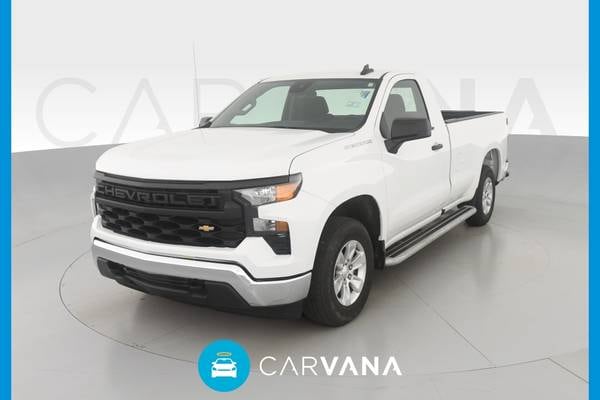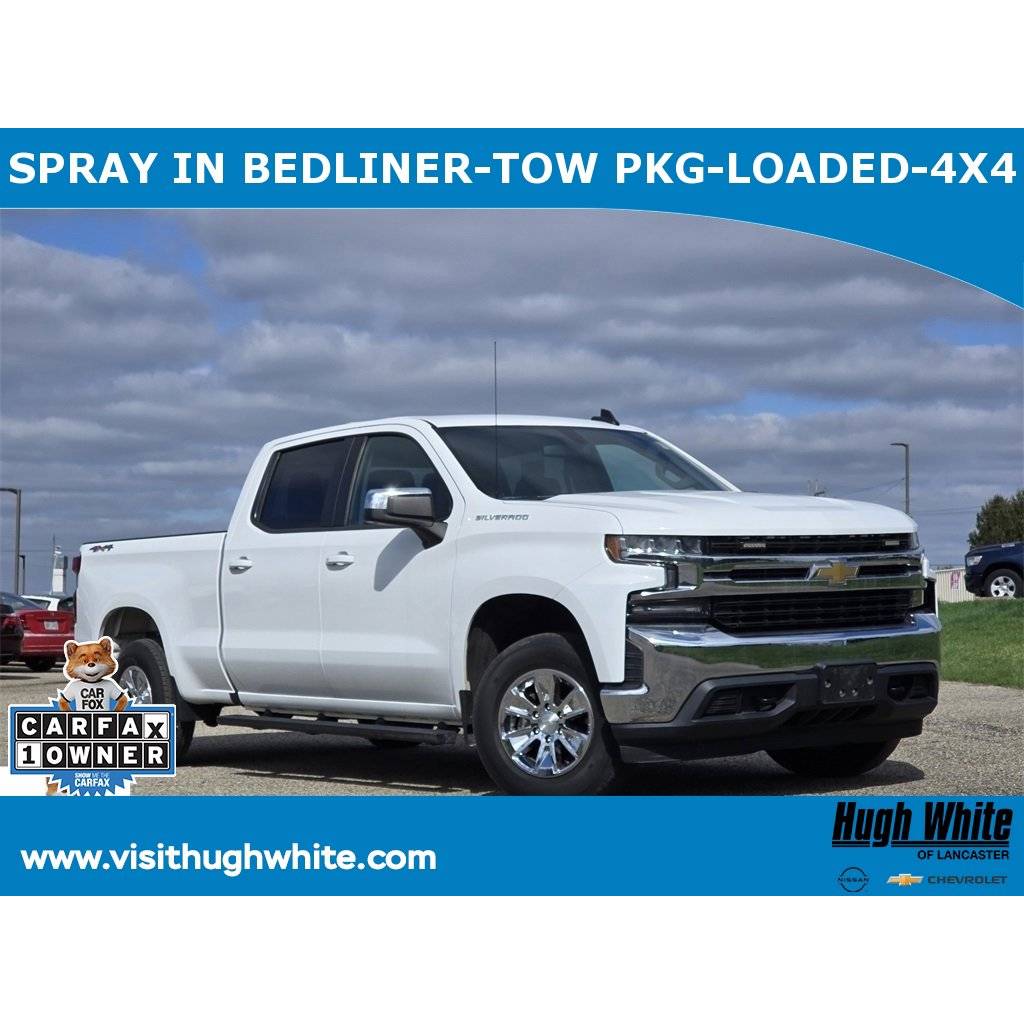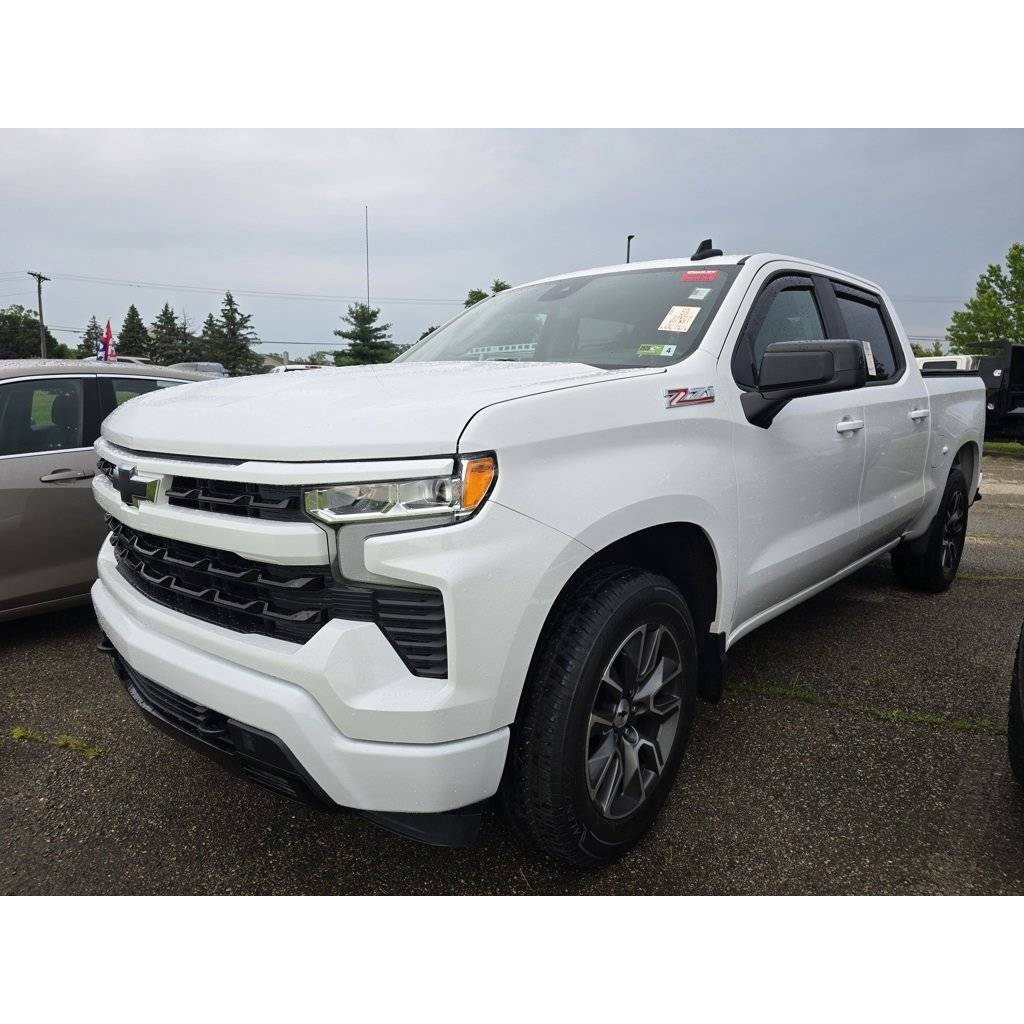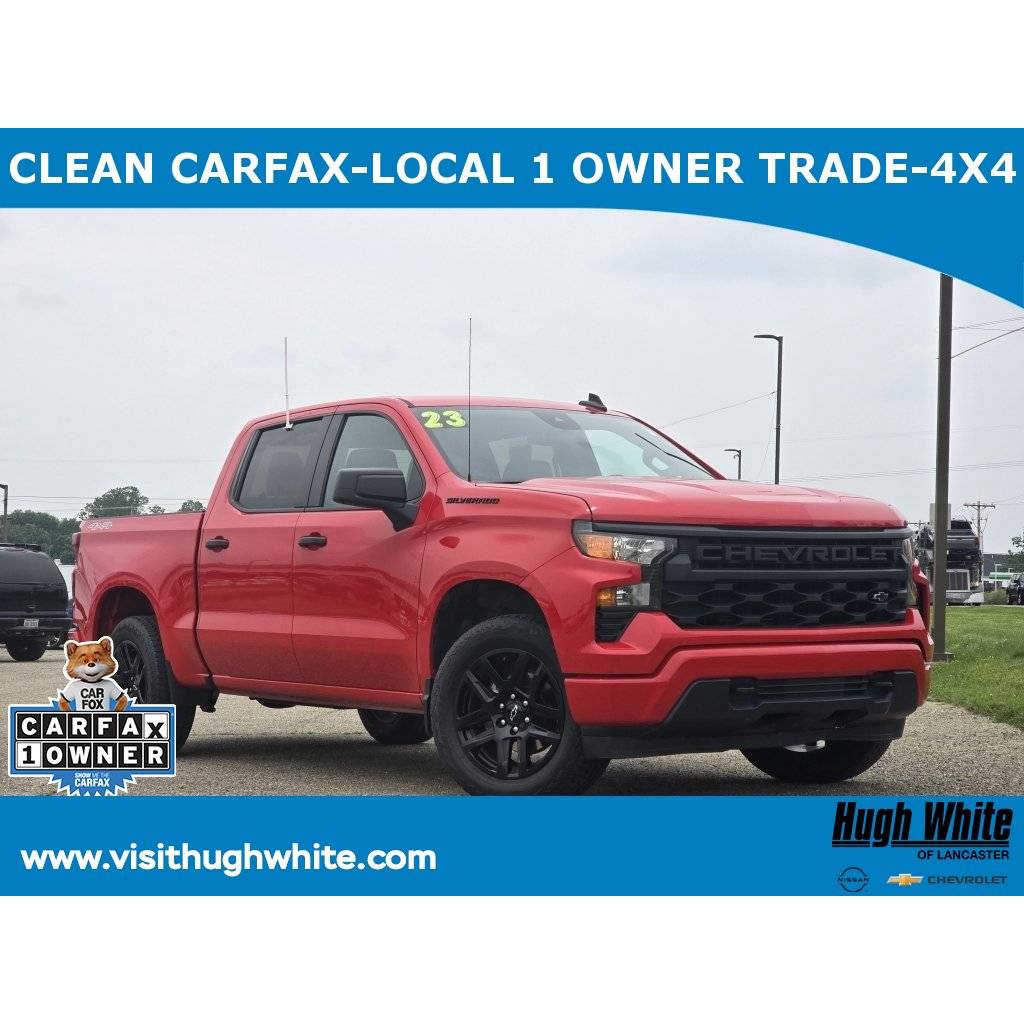- $28,990great price$4,037 below market
- 8,515 miles
- No accidents, 1 owner, personal use only
- 8'2” bed, 5.3l, 8cyl
- Carvana - Cincinnati (163 mi away)
- Home delivery*
Close
Located in Cincinnati, OH / 163 miles away from Coshocton, OH
At Carvana, we go miles beyond the extra mile. That's why we provide you with a convenient, fast, and hassle-free car buying experience that puts you ...
AutoCheck Vehicle History Summary
Accident Free Vehicle: Yes
Personal Use Only: Yes
History Provider: AutoCheck
Title Details: Clean Title
Salvage Vehicle: No
Frame Damage: No
Theft History: No
Lemon Status: No
Free History Report: No
Features and Specs:
20 Combined MPG (18 City/22 Highway)
Listing Information:
VIN: 3GCNAAED6RG348849
Stock: 2003699713
Certified Pre-Owned: No
Listed since: 05-15-2025 - $27,990great price$2,326 below market
- 14,246 miles
- No accidents, 1 owner, personal use only
- 8'2” bed, 5.3l, 8cyl
- Carvana - Cleveland (85 mi away)
- Home delivery*
Close
Located in Cleveland, OH / 85 miles away from Coshocton, OH
At Carvana, we go miles beyond the extra mile. That's why we provide you with a convenient, fast, and hassle-free car buying experience that puts you ...
AutoCheck Vehicle History Summary
Accident Free Vehicle: Yes
Personal Use Only: Yes
History Provider: AutoCheck
Title Details: Clean Title
Salvage Vehicle: No
Frame Damage: No
Theft History: No
Lemon Status: No
Free History Report: No
Features and Specs:
20 Combined MPG (18 City/22 Highway)
Listing Information:
VIN: 3GCNAAED5RG271598
Stock: 2003642093
Certified Pre-Owned: No
Listed since: 04-18-2025 - $28,100great price$2,942 below market
- 8,875 miles
- No accidents, 1 owner, personal use only
- 8'2” bed, 5.3l, 8cyl
- Auto Boutique Ohio (71 mi away)
- Home delivery*
Close
Located in Columbus, OH / 71 miles away from Coshocton, OH
*Disclaimer*PRICE LISTED DOES NOT INCLUDE TAX (TAX RATE VARIES DEPENDING ON STATE, CITY, & COUNTY), TITLE ($20), TEMP TAG ($20.50) MEMO-TITLE FOR REGI...
AutoCheck Vehicle History Summary
Accident Free Vehicle: Yes
Personal Use Only: Yes
History Provider: AutoCheck
Title Details: Clean Title
Salvage Vehicle: No
Frame Damage: No
Theft History: No
Lemon Status: No
Free History Report: No
Features and Specs:
Listing Information:
VIN: 3GCNAAED7RG314595
Stock: Y1594
Certified Pre-Owned: No
Listed since: 06-12-2025 - $28,590great price$2,657 below market
- 7,380 miles
- No accidents, 1 owner, personal use only
- 8'2” bed, 5.3l, 8cyl
- Carvana - Columbus (64 mi away)
- Home delivery*
Close
Located in Columbus, OH / 64 miles away from Coshocton, OH
At Carvana, we go miles beyond the extra mile. That's why we provide you with a convenient, fast, and hassle-free car buying experience that puts you ...
AutoCheck Vehicle History Summary
Accident Free Vehicle: Yes
Personal Use Only: Yes
History Provider: AutoCheck
Title Details: Clean Title
Salvage Vehicle: No
Frame Damage: No
Theft History: No
Lemon Status: No
Free History Report: No
Features and Specs:
20 Combined MPG (18 City/22 Highway)
Listing Information:
VIN: 3GCNAAED7RG415992
Stock: 2003647974
Certified Pre-Owned: No
Listed since: 04-15-2025 - $27,990great price$2,422 below market
- 12,848 miles
- No accidents, 1 owner, personal use only
- 8'2” bed, 5.3l, 8cyl
- Carvana - Cleveland (85 mi away)
- Home delivery*
Close
Located in Cleveland, OH / 85 miles away from Coshocton, OH
At Carvana, we go miles beyond the extra mile. That's why we provide you with a convenient, fast, and hassle-free car buying experience that puts you ...
AutoCheck Vehicle History Summary
Accident Free Vehicle: Yes
Personal Use Only: Yes
History Provider: AutoCheck
Title Details: Clean Title
Salvage Vehicle: No
Frame Damage: No
Theft History: No
Lemon Status: No
Free History Report: No
Features and Specs:
Listing Information:
VIN: 3GCNAAED4RG333119
Stock: 2003642092
Certified Pre-Owned: No
Listed since: 04-16-2025 - $23,998great price$3,579 below market
- 34,717 miles
- No accidents, 1 owner, corporate fleet vehicle
- 8'2” bed, 5.3l, 8cyl
- Price Pro (132 mi away)
Close
Located in Maumee, OH / 132 miles away from Coshocton, OH
Auto Start Stop, Android Auto, Apple CarPlay, Keyless Entry, Power Locks And Windows, Cruise Control, Backup Camera, Bluetooth Why pay Retail!! When y...
AutoCheck Vehicle History Summary
Accident Free Vehicle: Yes
Personal Use Only: No
History Provider: AutoCheck
Title Details: Clean Title
Salvage Vehicle: No
Frame Damage: No
Theft History: No
Lemon Status: No
Free History Report: No
Features and Specs:
Listing Information:
VIN: 3GCNAAED3NG544158
Stock: 24859JF
Certified Pre-Owned: No
Listed since: 04-02-2025 - $28,590good price$2,083 below market
- 10,831 miles
- No accidents, 1 owner, personal use only
- 8'2” bed, 5.3l, 8cyl
- Carvana - Cleveland (85 mi away)
- Home delivery*
Close
Located in Cleveland, OH / 85 miles away from Coshocton, OH
At Carvana, we go miles beyond the extra mile. That's why we provide you with a convenient, fast, and hassle-free car buying experience that puts you ...
AutoCheck Vehicle History Summary
Accident Free Vehicle: Yes
Personal Use Only: Yes
History Provider: AutoCheck
Title Details: Clean Title
Salvage Vehicle: No
Frame Damage: No
Theft History: No
Lemon Status: No
Free History Report: No
Features and Specs:
20 Combined MPG (18 City/22 Highway)
Listing Information:
VIN: 3GCNAAED3RG282129
Stock: 2003642089
Certified Pre-Owned: No
Listed since: 04-18-2025 - $28,990good price$1,800 below market
- 11,809 miles
- No accidents, 1 owner, personal use only
- 8'2” bed, 5.3l, 8cyl
- Carvana - Columbus (64 mi away)
- Home delivery*
Close
Located in Columbus, OH / 64 miles away from Coshocton, OH
At Carvana, we go miles beyond the extra mile. That's why we provide you with a convenient, fast, and hassle-free car buying experience that puts you ...
AutoCheck Vehicle History Summary
Accident Free Vehicle: Yes
Personal Use Only: Yes
History Provider: AutoCheck
Title Details: Clean Title
Salvage Vehicle: No
Frame Damage: No
Theft History: No
Lemon Status: No
Free History Report: No
Features and Specs:
20 Combined MPG (18 City/22 Highway)
Listing Information:
VIN: 3GCNAAED2RG341123
Stock: 2003647963
Certified Pre-Owned: No
Listed since: 04-16-2025 - $29,997fair price$370 below market
- 16,203 miles
- No accidents, 1 owner, personal use only
- 8'2” bed, 5.3l, 8cyl
- Brookville Chevrolet (158 mi away)
Close
Located in Brookville, PA / 158 miles away from Coshocton, OH
Priced below KBB Fair Purchase Price!CARFAX One-Owner.Summit White 2024 Chevrolet Silverado 1500 WT RWD 10-Speed Automatic EcoTec3 5.3L V8Recent Arriv...
AutoCheck Vehicle History Summary
Accident Free Vehicle: Yes
Personal Use Only: Yes
History Provider: AutoCheck
Title Details: Clean Title
Salvage Vehicle: No
Frame Damage: No
Theft History: No
Lemon Status: No
Free History Report: No
Features and Specs:
Listing Information:
VIN: 3GCNAAED9RG283141
Stock: 7988A
Certified Pre-Owned: No
Listed since: 04-21-2025 - $30,590fair price$432 below market
- 9,565 miles
- No accidents, 1 owner, personal use only
- 8'2” bed, 5.3l, 8cyl
- Carvana - Columbus (64 mi away)
- Home delivery*
Close
Located in Columbus, OH / 64 miles away from Coshocton, OH
At Carvana, we go miles beyond the extra mile. That's why we provide you with a convenient, fast, and hassle-free car buying experience that puts you ...
AutoCheck Vehicle History Summary
Accident Free Vehicle: Yes
Personal Use Only: Yes
History Provider: AutoCheck
Title Details: Clean Title
Salvage Vehicle: No
Frame Damage: No
Theft History: No
Lemon Status: No
Free History Report: No
Features and Specs:
20 Combined MPG (18 City/22 Highway)
Listing Information:
VIN: 3GCNAAED2RG397255
Stock: 2003645202
Certified Pre-Owned: No
Listed since: 04-15-2025 - $30,590good price$1,910 below market
- 13,075 miles
- No accidents, 1 owner, corporate fleet vehicle
- 8'2” bed, 5.3l, 8cyl
- Carvana - Cincinnati (163 mi away)
- Home delivery*
Close
Located in Cincinnati, OH / 163 miles away from Coshocton, OH
At Carvana, we go miles beyond the extra mile. That's why we provide you with a convenient, fast, and hassle-free car buying experience that puts you ...
AutoCheck Vehicle History Summary
Accident Free Vehicle: Yes
Personal Use Only: No
History Provider: AutoCheck
Title Details: Clean Title
Salvage Vehicle: No
Frame Damage: No
Theft History: No
Lemon Status: No
Free History Report: No
Features and Specs:
Listing Information:
VIN: 3GCNAAED4RG363379
Stock: 2003830426
Certified Pre-Owned: No
Listed since: 06-23-2025 - $23,329good price$2,341 below market
- 43,528 miles
- No accidents, 2 owners, personal use only
- 8'2” bed, 5.3l, 8cyl
- Jeff Wyler Chrysler Jeep Dodge Ram Ft Thomas (162 mi away)
Close
Located in Fort Thomas, KY / 162 miles away from Coshocton, OH
Jeff Wyler Chrysler Jeep Dodge Ram is proud to offer this dependable 2022 Chevrolet Silverado 1500 WT in Summit White. Well equipped with: Preferred E...
AutoCheck Vehicle History Summary
Accident Free Vehicle: Yes
Personal Use Only: Yes
History Provider: AutoCheck
Title Details: Clean Title
Salvage Vehicle: No
Frame Damage: No
Theft History: No
Lemon Status: No
Free History Report: No
Features and Specs:
Listing Information:
VIN: 3GCNAAED8NG556614
Stock: 2340241B
Certified Pre-Owned: No
Listed since: 06-06-2025 - $29,500good price$1,905 below market
- 12,905 miles
- No accidents, 1 owner, corporate fleet vehicle
- 8'2” bed, 5.3l, 8cyl
- Price Pro (132 mi away)
Close
Located in Maumee, OH / 132 miles away from Coshocton, OH
WT Fleet Convenience Pkg, OnStar Navigation System, Chrome Platform Running Boards, Keyless Entry, Power Locks And Windows, Cruise Control, Backup Cam...
AutoCheck Vehicle History Summary
Accident Free Vehicle: Yes
Personal Use Only: No
History Provider: AutoCheck
Title Details: Clean Title
Salvage Vehicle: No
Frame Damage: No
Theft History: No
Lemon Status: No
Free History Report: No
Features and Specs:
Listing Information:
VIN: 3GCNAAED3RG367021
Stock: 25554D
Certified Pre-Owned: No
Listed since: 05-23-2025 - $30,888fair price$1 above market
- 10,290 miles
- No accidents, 1 owner, personal use only
- 8'2” bed, 5.3l, 8cyl
- Brookville Chevrolet (158 mi away)
Close
Located in Brookville, PA / 158 miles away from Coshocton, OH
New Price!CARFAX One-Owner.Summit White 2024 Chevrolet Silverado 1500 WT RWD 10-Speed Automatic EcoTec3 5.3L V8Odometer is 1887 miles below market ave...
AutoCheck Vehicle History Summary
Accident Free Vehicle: Yes
Personal Use Only: Yes
History Provider: AutoCheck
Title Details: Clean Title
Salvage Vehicle: No
Frame Damage: No
Theft History: No
Lemon Status: No
Free History Report: No
Features and Specs:
Listing Information:
VIN: 3GCNAAED3RG291199
Stock: 7987A
Certified Pre-Owned: No
Listed since: 04-21-2025 - $29,990fair price$419 below market
- 13,359 miles
- No accidents, 1 owner, corporate fleet vehicle
- 8'2” bed, 5.3l, 8cyl
- Carvana - Cleveland (85 mi away)
- Home delivery*
Close
Located in Cleveland, OH / 85 miles away from Coshocton, OH
At Carvana, we go miles beyond the extra mile. That's why we provide you with a convenient, fast, and hassle-free car buying experience that puts you ...
AutoCheck Vehicle History Summary
Accident Free Vehicle: Yes
Personal Use Only: No
History Provider: AutoCheck
Title Details: Clean Title
Salvage Vehicle: No
Frame Damage: No
Theft History: No
Lemon Status: No
Free History Report: No
Features and Specs:
20 Combined MPG (18 City/22 Highway)
Listing Information:
VIN: 3GCNAAEDXRG272293
Stock: 2003737446
Certified Pre-Owned: No
Listed since: 05-24-2025 - $29,895fair price$669 below market
- 11,389 miles
- No accidents, 1 owner, personal use only
- 8'2” bed, 5.3l, 8cyl
- Cole Valley Chevrolet (78 mi away)
Close
Located in Newton Falls, OH / 78 miles away from Coshocton, OH
2024 Chevrolet Silverado 1500 WT in Summit White Vehicles Highlights include...., Home Of The Warranty Forever!, Backup Camera, Clean Vehicle History ...
AutoCheck Vehicle History Summary
Accident Free Vehicle: Yes
Personal Use Only: Yes
History Provider: AutoCheck
Title Details: Clean Title
Salvage Vehicle: No
Frame Damage: No
Theft History: No
Lemon Status: No
Free History Report: Yes
Features and Specs:
Listing Information:
VIN: 3GCNAAED2RG344474
Stock: A5546
Certified Pre-Owned: No
Listed since: 04-11-2025 - $30,459fair price$924 below market
- 14,658 miles
- No accidents, 1 owner, personal use only
- 8'2” bed, 5.3l, 8cyl
- Sunnyside Chevrolet (77 mi away)
Close
Located in Elyria, OH / 77 miles away from Coshocton, OH
Recent Arrival!CARFAX One-Owner.Certified. Summit White 2024 Chevrolet Silverado 1500 WT RWD 10-Speed AutomaticEcoTec3 5.3L V8Chevrolet Certifi...
AutoCheck Vehicle History Summary
Accident Free Vehicle: Yes
Personal Use Only: Yes
History Provider: AutoCheck
Title Details: Clean Title
Salvage Vehicle: No
Frame Damage: No
Theft History: No
Lemon Status: No
Free History Report: No
Features and Specs:
Listing Information:
VIN: 3GCNAAED4RG397239
Stock: C6007
Certified Pre-Owned: Yes
Listed since: 06-20-2025 - $31,650fair price$435 above market
- 7,188 miles
- No accidents, 1 owner, personal use only
- 8'2” bed, 5.3l, 8cyl
- Germain Hyundai (71 mi away)
- Five Star Dealer
Close
Located in Columbus, OH / 71 miles away from Coshocton, OH
Backup Camera, Bluetooth, Automatic Headlights, 2-Speaker Audio System, 40/20/40 Front Split Bench Seat, ABS brakes, Bluetooth® For Phone, Chevrolet C...
AutoCheck Vehicle History Summary
Accident Free Vehicle: Yes
Personal Use Only: Yes
History Provider: AutoCheck
Title Details: Clean Title
Salvage Vehicle: No
Frame Damage: No
Theft History: No
Lemon Status: No
Free History Report: No
Features and Specs:
Listing Information:
VIN: 3GCNAAED3RG316490
Stock: HBRG316490
Certified Pre-Owned: No
Listed since: 06-12-2025 - $29,300fair price$164 below market
- 22,245 miles
- No accidents, 1 owner, corporate fleet vehicle
- 8'2” bed, 5.3l, 8cyl
- Lambert Buick GMC (63 mi away)
Close
Located in Cuyahoga Falls, OH / 63 miles away from Coshocton, OH
Recent Arrival! Backup Camera, Silverado 1500 WT, 2D Standard Cab, EcoTec3 5.3L V8, 10-Speed Automatic, RWD, Although we make every effort to list equ...
AutoCheck Vehicle History Summary
Accident Free Vehicle: Yes
Personal Use Only: No
History Provider: AutoCheck
Title Details: Clean Title
Salvage Vehicle: No
Frame Damage: No
Theft History: No
Lemon Status: No
Free History Report: No
Features and Specs:
20 Combined MPG (18 City/22 Highway)
Listing Information:
VIN: 3GCNAAED8RG265097
Stock: R47211
Certified Pre-Owned: No
Listed since: 05-06-2025 - $30,853fair price$34 above market
- 8,922 miles
- No accidents, 1 owner, personal use only
- 8'2” bed, 5.3l, 8cyl
- Morris Buick GMC (80 mi away)
Close
Located in North Olmsted, OH / 80 miles away from Coshocton, OH
CARFAX One-Owner. Odometer is 2162 miles below market average! 2024 Chevrolet Silverado 1500 WT EcoTec3 5.3L V8 10-Speed Automatic RWD10-Speed Automat...
AutoCheck Vehicle History Summary
Accident Free Vehicle: Yes
Personal Use Only: Yes
History Provider: AutoCheck
Title Details: Clean Title
Salvage Vehicle: No
Frame Damage: No
Theft History: No
Lemon Status: No
Free History Report: No
Features and Specs:
Listing Information:
VIN: 3GCNAAED0RG403652
Stock: T7569
Certified Pre-Owned: No
Listed since: 05-07-2025 - $31,393fair price$797 above market
- 13,175 miles
- No accidents, 1 owner, personal use only
- 8'2” bed, 5.3l, 8cyl
- Germain Hyundai (71 mi away)
- Five Star Dealer
Close
Located in Columbus, OH / 71 miles away from Coshocton, OH
Backup Camera, Bluetooth, Automatic Headlights, 40/20/40 Front Split Bench Seat, ABS brakes, Bluetooth® For Phone, Chevrolet Connected Access Capable,...
AutoCheck Vehicle History Summary
Accident Free Vehicle: Yes
Personal Use Only: Yes
History Provider: AutoCheck
Title Details: Clean Title
Salvage Vehicle: No
Frame Damage: No
Theft History: No
Lemon Status: No
Free History Report: No
Features and Specs:
Listing Information:
VIN: 3GCNAAED3RG299531
Stock: HBRG299531
Certified Pre-Owned: No
Listed since: 06-12-2025
Consumer Reviews for the Chevrolet Silverado 1500
2023 Silverado Reg Cab Longbed 2.7 4cyl
Applied Filters5Active
Make & Model
Year
New / Used
Price & Payments
Price Rating
Trim
Truck Details
Mileage
Accidents & History
Engine & Drivetrain
Exterior Color
Interior Color
Total Seating
Edmunds Review
Features
Options & Packages
MPG
* Delivery of any kind does not apply to Alaska and Hawaii. Contact the dealer for delivery details, restrictions and costs.
























